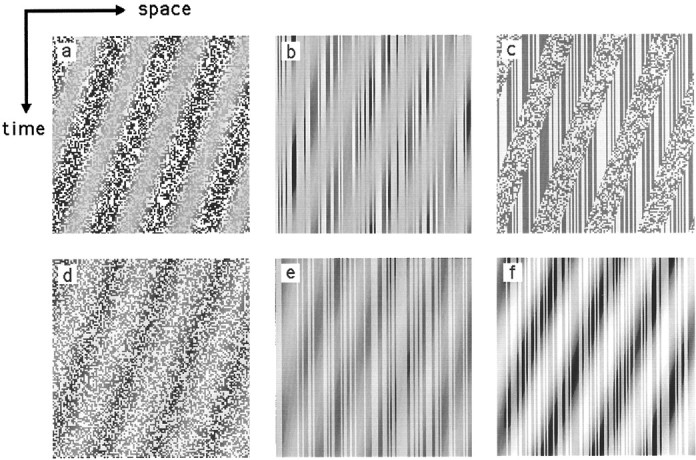Fig. 2.

Space–time plots illustrating the various types of motion stimuli used in the experiments. Each plot represents a section along the radius of the circular grating in the original image (shown horizontally) seen at successive points in time (represented vertically). a, Contrast-modulated, two-dimensional dynamic noise (2ndDyn). Eachframe consists of 2-D noise the contrast of which is sinusoidally modulated. On each update (every 30 msec), the noise sample is replaced by a new one, and the contrast modulation moves a short distance to the left, giving smoothleftward motion over time. b, Contrast-modulated, two-dimensional, high-pass-filtered static noise (2ndFilt). In this case, the carrier is again 2-D noise, but this time the noise is filtered to remove the lowest spatial frequencies, and the noise sample remains the same over time. Again, the contrast envelope drifts smoothly to the left. c, Flicker-frequency-modulated two-dimensional noise (2ndFlick). Eachframe consists of binary, two-dimensional noise of uniform contrast, and no spatial structure is visible within it. Over time, the noise sample is replaced in some areas but not in others to form a frequency-defined grating. The boundaries of the regions in which the noise is dynamic drift smoothly leftward over time. d, Luminance-modulated, two-dimensional dynamic noise (1stDynLow). Each frame consists of 2-D noise the luminance of which is sinusoidally modulated with an amplitude calculated to give similar visibility to the contrast modulation shown in a. On each update, the noise sample is replaced, and the luminance modulation moves to the left.e, Luminance-modulated, two-dimensional, high-pass-filtered static noise (1stFiltLow). The noise is the same as that in b, and the luminance is modulated to give similar visibility to the contrast modulation in b.f, Luminance-modulated, two-dimensional, high-pass-filtered static noise (1stFiltHigh). The noise is the same as that in e except that the amplitude of the luminance modulation is much greater.
